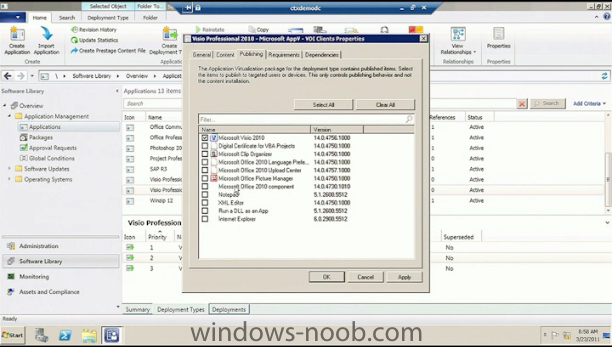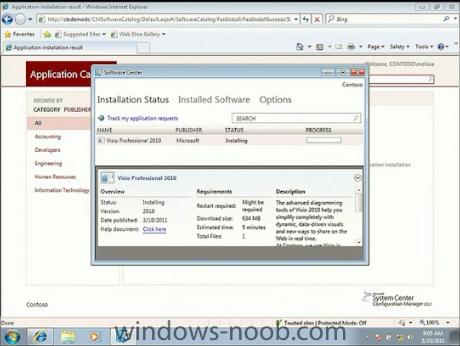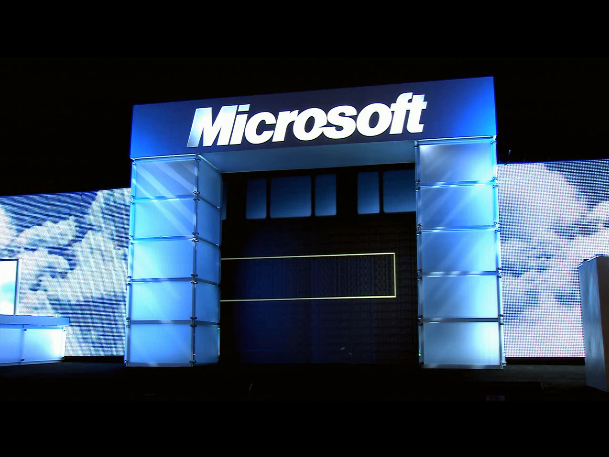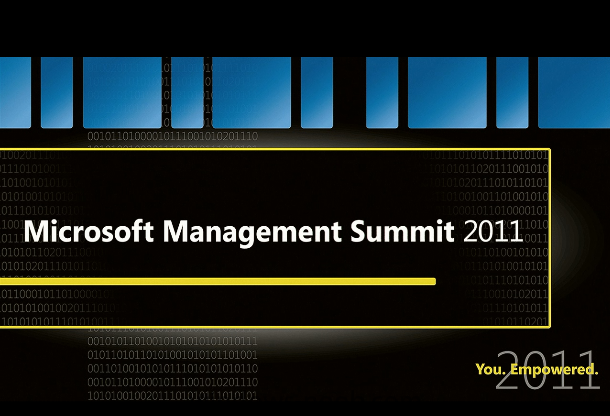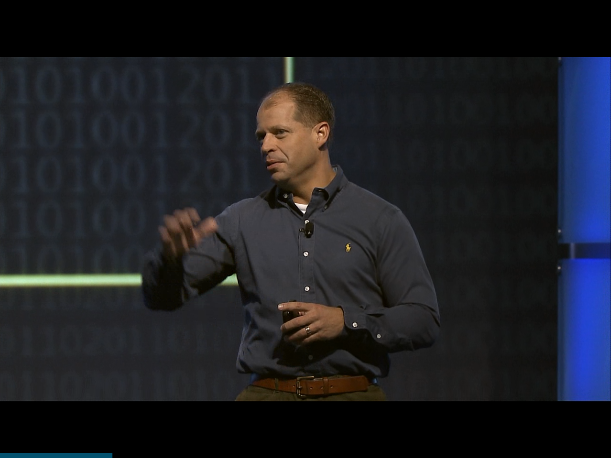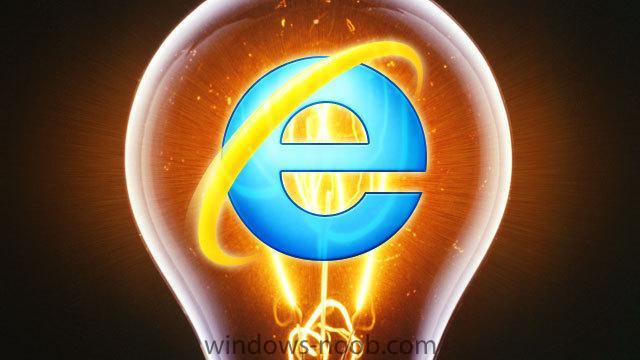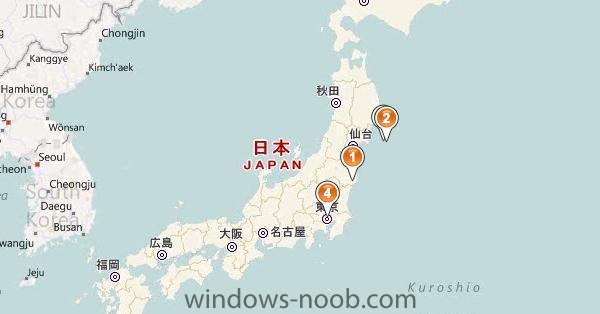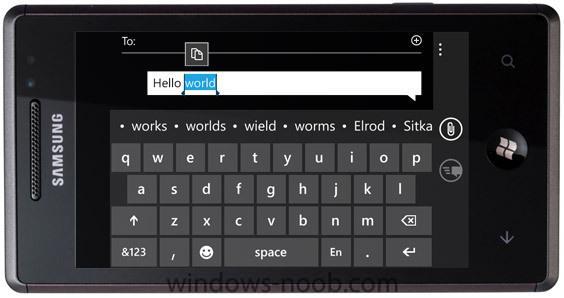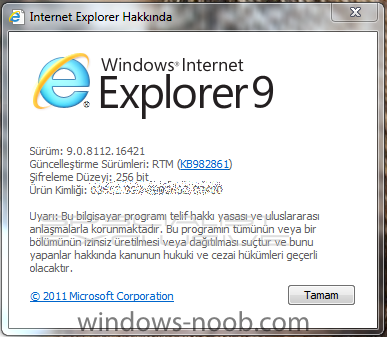-
Posts
9182 -
Joined
-
Last visited
-
Days Won
366
Everything posted by anyweb
-
the recommended method is to Build and capture, but if you really want to just capture then follow the how Can I capture windows 7 guide here How can I capture Windows 7 Capturing Windows 7 using a custom task sequence I hope you are trying beta 2 as it's now available, ie: don't use beta 1 anymore cheers niall
-
The day 2 keynote at MMS was focused on empowering IT, and the consumerization of IT - how can IT enable users to use at work the devices they use at home. The keynote covered new ways to manage mobile devices, easily deploy and manage software, patch and manage machines, regardless of where they are, and much more. Below is a screenshot of SCCM 2012 Beta 2 at MMS 2011 and here we can see a Windows 7 client getting software via the Software Catalog/Software Center features in SCCM 2012 beta 2 http://technet.microsoft.com/en-us/edge/video/mms-2011-day-2-keynote
-
sounds like you have issues on the site server, how are your site component status's showing up ? all green or any problems ?
-
The Configuration Manager Team is pleased to announce the release of Configuration Manger 2012 Beta 2! It is now available on Connect: https://connect.microsoft.com/ConfigurationManagervnext/Downloads/DownloadDetails.aspx?DownloadID=34794 Please reference the Supported Configuration Document and Release Notes which can be found on: http://download.microsoft.com/download/5/4/5/54508737-EB00-4B65-8DB3-F0D810FA3A9F/Configuration Manager 2012 Beta 2 Supported Configuration.pdf http://technet.microsoft.com/en-us/library/gg703318.aspx A few notes before you get started: 1. Please use only SQL Server 2008 SP1 and CU 10 or 11 (SQL 2008 SP2 or SQL 2008 R2 is not supported) 2. Ensure site server computer has internet access to download pre-requisites or run setupdl.exe from an internet connected computer 3. Ensure Windows Firewall is either disabled or SQL ports 1433 and 4022 are openon the CAS and Primary site. 4. To manage Windows XP SP3 non-English clients, locate and download the Windows Remote Management update from the following location: http://support.microsoft.com/kb/936059. This update is needed to prevent the client from continually attempting remediation. Please see relnotes for more information. 5. From the Microsoft Connect site (https://connect.microsoft.com/ConfigurationManagervnext/Downloads/DownloadDetails.aspx?DownloadID=29497), download the software update WSUS-KB131665-x64.exe and install the software update on all software update point site system rolesif you are usingSoftware Update Point based client deployment. Please see relnotes for more information. 6. For task sequence deployments the option for downloading content from the DP and running it locally will not work and will result in errors in the tsagent.log Workaround is to download content from the DP when requiredand run locally. Please see relnotes for more information 7. Configuration Manager Network Access Protection is not supported in this release You many also reference How to videos posted on TechNet: http://technet.microsoft.com/en-us/systemcenter/cm/gg721914.aspx We look forward to your feedback! Please submit your feedback regularly using the Feedback Form (https://connect.microsoft.com/ConfigurationManagervnext/feedback/CreateFeedbackForm.aspx?FeedbackFormConfigurationID=4216&FeedbackType=1). Thank you, Configuration Manager Customer Team
-
thanks for the kind words ! as regards the computer import problem, look at this hotfix The computer associations are not created by the import computer information wizard in SCCM 2007 Service pack 2 http://support.microsoft.com/?kbid=980270
-

OS Install - "No Task Sequences Available to this computer.."
anyweb replied to flyinghaggis's question in Deploy 7
use computer association to import this computer into a collection that contains the Advertisement (of the new OS) then try again, or enable the Unknown Computers collection ability on your PSP (PXE service point) (need R2 or R3) and advertise the same TS to the Unknown Computers collection -
The MMS 2011 Day 1 keynote was all about private cloud. Previews of new System Center 2012 products, like VMM 2012 and Concero, and lots of other cool stuff. This is the complete feed from the keynote – the action starts at the 17 minute mark. watch the video here > http://technet.microsoft.com/en-us/edge/mms-2011-day-1-keynote.aspx alt link > http://www.ditii.com/2011/03/23/mms-2011-virtual-machine-manager-2012-beta-plus-day-1-keynote/
-
the program will be run as local system account so no problems there, have you enabled logging for your actual MSI ? that is the log file we need to see as the 1603 error is extremely generic
-
here's Jason Sandys excellent Startup Script http://myitforum.com/cs2/blogs/jsandys/Script/ConfigMgrStartup1.03.zip read the code for details about what it does, cheers niall
-

Configuration Manager Client Health Check Tool
anyweb posted a question in Troubleshooting, Tools, Hints and Tips
If you want a really good client health check tool (scripts) then look no further, Dan Thomson has created the below after many years of working on it and developing, cheers niall Project Description There are many pitfalls with maintaining ConfigMgr managed systems so they install the client software and can continuously report to the hierarchy. This project provides a scripted solution that detects many issues and automates their repair. The downloads locations: * The scripts are on the Source Code page * The Documentation is on the Documentation page and included in the source Introduction Poor system health…many have felt the pain and some are blissfully ignorant. Others however, are benefiting from a well run change management process and aren’t too poorly affected. Unfortunately, without a proper running operating environment, the Configuration Manager (ConfigMgr) client will face certain doom. This includes, at minimum, the inability to install itself on designated systems, a failure to discover its site assignment and receive policies, a lack of being able to report inventory or heartbeats, and not being able to process software and patch deployments. Where does that leave the intrepid administrator? ConfigMgr has some in-built features that aid in identifying systems with issues. These mainly come in the form of reports. There also exist some third party add-ons and community scripts of various forms and thoroughness that attempt to identify and automate the correction of known issues. The community scripts are generally deployed by means of a Group Policy Object (GPO) computer startup script. The Problem As mentioned previously, the ConfigMgr client will have various issues if the hierarchy and the client system are not properly configured. Various other issues exist even when the ConfigMgr client is working properly. These include stale items remaining in the client cache, reported inventory being lost in transmission to the client’s assigned server, and so on. With the Health Check Tool, we are going to focus on the health of the client system and the ConfigMgr client itself. We want to make sure the client system is properly configured with its services; its environment (%Path%, %Temp%, and %Tmp% variables); its ability to install the ConfigMgr client; and for the ConfigMgr client to get policies, run inventory, and install software and patches. Some of the issues can also be compounded by poor change management and unskilled administrators. Keeping up with client health is a daunting objective without an automated means to identify, report, and repair problems. The Solution Even though my environment now has one of the third party add-ons with a limited deployment base, there was a time when such a tool was not available. A co-worker and I were forced to create a solution by gathering the available community scripts and tailoring them into something that met our initial needs. That was a few years ago. Since then, I have been keeping up with the development and am now offering the solution to the community in hopes others can benefit as much as I do. The solution being offered is an automated two step process (a third step is on its way in the near future). The automation for these steps comes via: 1. The Health Check Tool.cmd –a command script 2. The Health Check Tool.wsf –a Windows Script Host script When these scripts run, they will record their activities to the %WinDir%\Temp\Health Check Tool.log file. Additionally, there is some tracking information written to the registry at the location specified by the RegistryStorePath option. This includes: 1. The name of the system the tool last ran on. This is useful if the client system turns into an image master or is renamed. If a change is noticed, the Health Check Tool will do a review of the EndPointQueues to determine if there might be a problem with the ConfigMgr client saving policies to WMI in future policy downloads. 2. The last date and time the Health Check Tool ran. 3. The last error codes that correspond to any detected known issues. 4. The last repairs that were conducted to fix known issues. I opted to use this multi step process so I could overcome various hurdles. Some of these are: 1. Some systems are not able to run certain scripts because the Windows Script Host is broken for some reason. 2. Running the health checks too soon after startup could produce inaccurate results and will most likely interfere with the startup of the system and the ConfigMgr client. 3. The scheduled task allows the health checks to be run on a normal schedule without requiring the client system to be restarted. download > http://configmgrclienthtc.codeplex.com/ -

using vNext in a LAB - Part 1. Installation
anyweb replied to anyweb's topic in Configuration Manager 2012
as Peter says' it's a beta product so should only be used in a LAB environment to experiment with how the new version will look like, do not implement this version of ConfigMgr in a Production Environment, Microsoft does do carefully agreed upon TAP releases, if you have a customer that is interested in trialling beta software then speak to your Microsoft TAM -

How can I capture an Windows 7 computer
anyweb replied to Stijn's topic in Configuration Manager 2012
the smsts.log is found in various places, read this post to get details about it.. -
great work thanks for sharing and feel free to post that guide in the MDT part of windows-noob also
-
Internet Explorer 9 has now been downloaded 2.35 million times in the first 24 hours since its Monday night release. That is over 27 downloads every second, or over 240 downloads every 9 seconds. Wow. We want to thank everyone around the world for downloading IE9 and the enthusiastic reception. 2.3 million downloads in 24 hours is over double the 1 million downloads we saw of the IE9 Beta and four times that of the IE9 RC over the same time period. In case you missed it, check out the collection of videos from the SxSW launch event. Ze Frank’s demo of Star.ME is one not to be missed! You can see all of the demos and the complete launch event by clicking play below. And to download Internet Explorer 9 for yourself, visit http://www.beautyoftheweb.com. via > http://windowsteamblog.com/ie/b/ie/archive/2011/03/16/2-3-million-downloads-of-ie9-in-the-first-24-hours.aspx
-

The most modern browser there is: Internet Explorer 9 reviewed
anyweb posted a topic in Windows News
When Microsoft first introduced Internet Explorer 9 at PDC in November 2009, it didn't show much. A few benchmarks, some talk about the technologies that the browser would use, and a little information about the direction that development would take. But it was a significant event nonetheless. After years of playing catch-up—the stopgap Internet Explorer 7 added tab support, and then the solid Internet Explorer 8, which offered little in the way of support for new Web innovations—Microsoft was starting to position its browser not only as good, but able to take on the competition and be best in class. And with the release today of Internet Explorer 9, the company has gone on to deliver just that—IE9 is the most modern browser there is. Microsoft set out to do four things with IE9. The browser had to be fast, it had to be standards-compliant, it had to be trustworthy, and it had to put the focus on sites and Web content, rather than the browser. Ars has been following the browser's development since the first public preview in March 2010, with extensive coverage of the beta and release candidate, but those major points are still worth looking at. Focus on sites Internet Explorer 7, and then Chrome, have ushered in a trend for stripped-down browser interfaces. Internet Explorer 7 ditched the menu bar by default (though this default was later changed), and Chrome took this design a step further by putting its tabs on top and all but abandoning the toolbar concept. Internet Explorer 9 builds on—or rather, subtracts from—the work done in previous Internet Explorer versions. Its interface is stripped down, clean, and simple. The intent is that the site should be the focus, not the browser frame. So tabs have moved alongside the address bar—though they can be moved below it if desired—the status and menu bars are gone by default, the toolbars are gone by default, and the icons on the buttons use new artwork. read the entire story > http://arstechnica.com/microsoft/reviews/2011/03/the-most-modern-browser-there-is-internet-explorer-9-reviewed.ars -

Error in Deploying MSU FILE
anyweb replied to rotem's question in Deploy software, applications and drivers
to install a patch just try a run command line step like this wusa.exe "Windows6.1-KB2443685-x86.msu" /quiet /norestart cheers niall -
Microsoft is rumored to be preparing an “Aero Lite” UI for Windows 8 according to leaked components from a recent build. The “Aero Lite” UI is likely replace the Windows 7 Basic interface. Microsoft originally invented the Basic UI for those unable to run the full Windows Aero experience. Windows 8 is rumored to include a full 3D interface which has so far failed to leak out of Redmond’s tight ship. The Aero Lite UI has been revealed in msstyles files supplied to Angel of Despair. The new user interface is rumored to feature some flat Metro styles, similar to those found in Microsoft’s Media Center application and Windows Phone 7. Microsoft’s primary Windows 8 interface is believed to be fully 3D. The interface will be “fully dynamic” and able to adapt to user habits. Icons and shortcuts will adapt to different usage scenarios to speed up daily tasks. Windows 8 is also rumored to include a new fast hibernation system. The system will hibernate in around three to six seconds and save all open documents and running tasks. Rumors suggest that Microsoft will create a dual-UI for Windows 8. A tile-based user interface codenamed “Mosh” will reportedly be included. Microsoft has so far been extremely quiet on the Windows 8 front. Windows Chief, Steven Sinofsky, took to the stage at the Consumer Electronics Show in Las Vegas in January to introduce a technology preview of Microsoft’s Windows ARM support and show off an early build of Windows 8. Microsoft is partnering with ARM-based manufactures NVIDIA, Qualcomm and Texas Instruments to produce new Tablet devices. Steve Ballmer has described the next release of Windows as the company’s “riskiest product bet”. It is understood that Microsoft will feature deep cloud integration into the future OS to realise its vision of “three screens and a cloud”. One Microsoft employee recently said he believes Windows 8 will be the “most important Windows ever shipped.” via > http://www.winrumors.com/microsoft-preparing-metro-inspired-aero-lite-ui-for-windows-8/?utm_source=windows-noob.com
- 1 reply
-
- 1
-

-

using vNext in a LAB - Part 1. Installation
anyweb replied to anyweb's topic in Configuration Manager 2012
it might matter if you chose different settings on a different site server, unless you have a good reason i would stay with the default collation settings -
Microsoft’s Windows Phone 7 “NoDo” update is due later this month but here’s a quick look at its key features. Microsoft has promised improved application resume times and better marketplace search alongside a new copy and paste feature. The company has delivered on all three with “Nodo”. First up is copy and paste. Microsoft’s copy and paste implementation does the job but is difficult and fiddly to use. I had troubles getting the copy dialog box to surface on multiple occasions and it seems to respond randomly to various means of tapping on the screen. Copying isn’t always copying either, pictures do not copy despite being selectable. I tested copy and paste in native Windows Phone applications to ensure this wasn’t an experience broken by a third party. All-in-all copy and paste feels rushed and like an afterthought from Microsoft, it could be a lot better. Second is Microsoft’s performance improvements for resuming applications. I found that several games resumed a lot quicker than before, despite the differences in devices. This is a welcome improvement for Windows Phone as the company strives towards “Mango” where it will offer full multitasking across its operating system. The last and final key improvement in “NoDo” is the Marketplace search improvements. Searching for generic sounding applications or even ones named “Twitter” or “Frogger” would often displace search results on the device. Relevant applications would end up at the bottom of lists following music and artist information. Microsoft has changed this search behaviour in “NoDo” and it’s greatly improved. It’s now much easier to find applications within the Marketplace. Overall, Microsoft’s “NoDo” update brings little to be excited about as a Windows Phone 7 owner. The improvements are minor and ones that could have arguably been part of the original RTM build. Microsoft has officially confirmed that “NoDo” will be distributed in “the latter half of March”. The company is widely expected to make the update available in the week of March 21 with several carriers suggesting March 24 as a launch date. via > http://www.winrumors.com/first-impressions-windows-phone-7-nodo-update-video/?utm_source=twitterfeed&utm_medium=twitter&utm_campaign=Feed%3A+WinRumors+%28WinRumors%29&utm_content=Twitter
-
Microsoft is among the many U.S. companies whose operations were impacted by the massive earthquake and tsunami in Japan. Here’s a status report from the company, issued yesterday afternoon and still current as of this morning. We’ll post further updates as they’re available. Microsoft has activated its Disaster Response protocol and is currently accounting for all of its employees and assessing all of its facilities for any impact. The company is reaching out to its customers and partners to conduct impact assessments. We do know at this time that there is no disruption to Microsoft’s cloud based and hosted services. Microsoft is starting to reach out to provide free incident support to help our customers and partners impacted by the earthquake to get their operations back up and running. The company provides free temporary software licenses to all impacted customers and partners as well as lead, governments, non-profit partners and institutions involved in disaster response efforts. Exchange Online will be made available at no cost for 90 days to business customers in Japan whose communications and collaboration infrastructure may be affected. Microsoft hopes this will help them resume operations more quickly while their existing systems return to normal. Microsoft is also contacting customers, local government, inter-government and non-government agencies to support relief efforts. Microsoft has a disaster response cloud based communications portal based on Windows Azure available that governments/NGOs can use to communicate with citizens or intra-agency for information, situational awareness and communication purposes. Bing Maps currently provides imagery of the area and are working on securing before and after imagery for a disaster response mapping application. On Microsoft’s disaster response site, the company has listed ways for people to help, including links to several non-profit organizations that are offering support to help victims of the Japanese quake. via > http://www.geekwire.com/2011/status-report-microsoft-japan
-
Windows 7 SP1 hasn’t been out too long, but Lenovo and Hewlett-Packard have already said they are going to start shipping it pre-loaded on their machines. Laptops and desktops from Lenovo will be shipped with Windows 7 service pack 1 starting in early April. Hewlett-Packard have said they are planning shipments of business PCs preloaded with Windows 7 SP1 soon afer. HP won’t be shipping consumer PCs with the service pack until around mid-June however, as they are going to wait until their back-to-school-product launch. Windows 7 SP1 was made available at the end of February to the public, while Technet and MSDN subscribers got their hands on it about a week before. At the moment most users should probably have it installed if they have their Windows Update center configured to automatically download and install new updates. SP1 didn’t contain any major fixes, but it does patch up and fix a few little bugs that Microsoft have discovered since Windows 7 was released by in October 2009. Dell have declined to say when they are going to start shipping their machines with the service pack installed, but their CEO Michael Dell said in the past that PC’s with Intel’s Sandy Bridge processors and Windows 7 Service Pack 1 could boost the client PC refresh cycle. Microsoft haven’t yet released any Windows 7 installation media with SP1 to PC Makers, and we’re still not sure when they will. Currently PC Makers have to manually install SP1, a process which can take hours. More than likely, the sooner Microsoft release Windows 7 SP1 media, the sooner it will start shipping on machines. via > http://www.windows7news.com/2011/03/12/windows-7-sp1-coming-loaded-pcs-early-april/
-
If you’re a Windows Phone 7 user, you’re likely frustrated at the lack of Windows Phone 7 (WP7) updates since launch. Now, before you yell “They aren’t slow!” you should take a look at this post by Paul Thurrott. The fact is that if you purchased a WP7 at launch, it’s been a long wait for a wide range of performance and bug fixes, and for the implementation of copy and paste. This is the update that's been causing a lot of 'anxiety'. Luckily Microsoft is paying attention. Eric Hautala, whose job it is to get these updates out to WP7 users worldwide, has just shed some light on the update process for WP7. In short, Eric acknowledges that they have been slow and that the slowness is causing many of us to be “understandably anxious”. He explains that with 9 handsets on 60 carriers (in 30 countries), the process can be complex. After Microsoft and the OEMs complete their parts of the update, all of the carriers have to test the update on their networks to ensure that it doesn’t cause any problems for them or their customers. The various carriers have different testing times and requirements, which can hold up rollouts of updates, and Eric emphasizes that this is normal practice for rolling out software updates on any phone – he however doesn’t mention that Apple bypasses carriers completely when rolling out updates. The potential for carriers to block updates has been a big concern for a number of WP7 users, and Eric doesn’t actually discount the theory that carriers can block updates. Instead, he explains that Microsoft works hard with carriers to get updates out on time and that WP7 users “should ultimately receive all the updates” that Microsoft sends out. Note the usage of the word “should”. So what’s the good news in all this? Well, Microsoft is listening. It’s likely that they’ll learn from their mistakes and the publicity those mistakes have had, and they’ll be working to improve future update rollouts. Eric also says that the delayed launch of NoDo “should in no way impact the timing of future updates, including the one announced recently at Mobile World Congress featuring multitasking, a Twitter feature, and a new HTML 5-friendly version of Internet Explorer Mobile.” via > http://www.neowin.net/news/microsoft-details-the-complicated-wp7-update-process
-
It seems that Microsoft has signed off the RTM build of Internet Explorer 9 just a few days before the final version is released to the web on Monday. According to a number of Russian sites, the RTM build is 9.00.8112.16421.110308-0330 and was compiled on March 8. Earlier in the week, Microsoft officially confirmed that Internet Explorer 9 will be launching at 9 PM PST on March 14 as was previously predicted by Neowin back in February. The launch will take place as part of their "Beauty of the Web" event, which will be hosted by the Internet Explorer 9 team in Austin City Limits Live. The event will begin at 9 PM on Monday, March 14, 2011 at the Moody Theater. The event will also mark a year to the day that Microsoft launched the first Platform Preview of Internet Explorer 9 to developers and the public. Microsoft also confirmed that the public would be able to download the final version of the popular browser at 9 PM PST. Users who have already downloaded the release candidate version of the browser will automatically be updated to the final version, most likely via Windows Update. via > http://www.neowin.net/news/internet-explorer-9-hits-rtm-build



